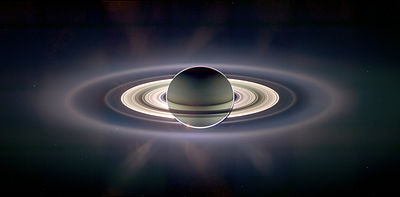Saturn’s Rings
Why are the rings of Saturn so beautiful?

The photo to the right was taken by the Cassini spacecraft when the sun was behind the planet, and backlighting the rings and the edge of the atmosphere. A type of solar eclipse never before seen by humans!
The rings are composed of millions of small particles, mostly ice, orbiting Saturn. They are neither arranged in a uniform disc, nor are they evenly spaced like the grooves on a record. Instead, they have an exquisite natural pattern, not quite like anything I know of on Earth. Click the image below for a full size, zoomable version. The bright bands are higher density, dark ones lower density.
As with so many patterns in nature, this one is generated by simple rules. The main generator of the ring patterns is orbital resonance. The chunks that form the rings come in all sizes, from dust grains to small moons. When the orbital periods of two bodies are related to each other by a ratio of small whole numbers (sound familiar?), they will have a lot more gravitational influence on each other, just like the playground swing example from the last post. They give each other a little kick every time they come around, and either the relationship is unstable (one or both get booted out of their orbit) or stable (they settle in to a pattern and their resonance locks them into, um, harmony).
There are other examples in the Solar System. Pluto and Neptune are in a 3:2 resonance. Pluto orbits the sun twice for every three times Neptune goes around, and the relationship has persisted for a long time. They are playing a very slow perfect fifth. Orbital resonance draws them into this pattern. The legs are kicking at just the right time.
I think there is a very real connection between the beauty of the rings and the beauty of harmony. Stand close to someone, and sing a note while the other person sings a perfect fifth above. I think you will feel the resonance in your vocal cords, as it draws you into entrainment. Resonance influences and creates physical structures on every scale from subatomic particles to spiral galaxies.
Once again, I propose that when we experience the joy of musical harmony, we are seeing (and hearing and feeling) a little more deeply into the nature of the universe. The window is resonance. Here’s an interesting site with lots more about the connections between physics, sound and resonance.
And, to ride my hobby horse for just a second, I believe the dominance of equal temperament has obscured this deep insight and feeling. For many notes, the legs just don’t kick at quite the right time. No worries, I do think equal temperament is extremely useful, and it’s been used to make a whole lot of gorgeous music. I use it myself. But it has distanced us somewhat from the shot of pure joy that the resonances of music, in tune, can deliver. I’m hooked on the straight stuff, and the reason I’m writing this blog is the desire to share that joy.
Actually, I do know of an Earthly structure that resembles Saturn’s rings. It’s the scale, in just intonation.
Next: Extending the lattice

